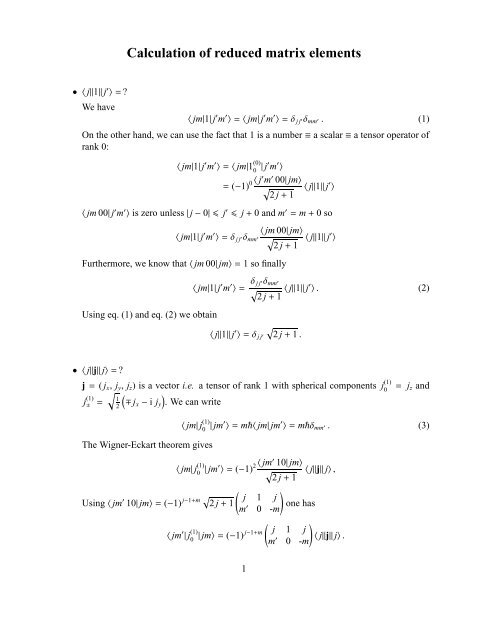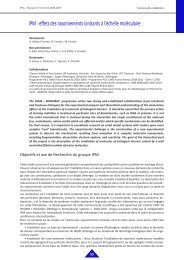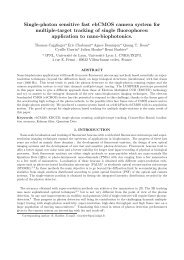Calculation of reduced matrix elements - IPNL
Calculation of reduced matrix elements - IPNL
Calculation of reduced matrix elements - IPNL
Create successful ePaper yourself
Turn your PDF publications into a flip-book with our unique Google optimized e-Paper software.
<strong>Calculation</strong> <strong>of</strong> <strong>reduced</strong> <strong>matrix</strong> <strong>elements</strong><br />
•〈 j‖1‖ j ′ 〉= ?<br />
We have<br />
〈 jm|1| j ′ m ′ 〉=〈 jm| j ′ m ′ 〉=δ j j ′δ mm ′. (1)<br />
On the other hand, we can use the fact that 1 is a number≡ascalar≡atensor operator <strong>of</strong><br />
rank 0:<br />
〈 jm|1| j ′ m ′ 〉=〈 jm|1 (0)<br />
0 | j′ m ′ 〉<br />
= (−1) 0〈j′ m ′ 00| jm〉<br />
√<br />
2 j+1<br />
〈 j‖1‖ j ′ 〉<br />
〈 jm 00| j ′ m ′ 〉 is zero unless| j−0| j ′ j+0 and m ′ = m+0 so<br />
〈 jm|1| j ′ m ′ 〈 jm 00| jm〉<br />
〉=δ j j ′δ mm ′ √ 〈 j‖1‖ j ′ 〉<br />
2 j+1<br />
Furthermore, we know that〈 jm 00| jm〉=1so finally<br />
Using eq. (1) and eq. (2) we obtain<br />
〈 jm|1| j ′ m ′ 〉= δ j j ′δ mm ′<br />
√<br />
2 j+1<br />
〈 j‖1‖ j ′ 〉. (2)<br />
〈 j‖1‖ j ′ 〉=δ j j ′√<br />
2 j+1.<br />
•〈 j‖j‖ j〉= ?<br />
j=( j x , j y , j z ) is a vector i.e. a tensor <strong>of</strong> rank 1 with spherical components j (1)<br />
0<br />
= j z and<br />
( )<br />
j (1)<br />
± = ∓ jx − i j y . We can write<br />
√<br />
1<br />
2<br />
The Wigner-Eckart theorem gives<br />
〈 jm| j (1)<br />
0 | jm′ 〉=m〈 jm| jm ′ 〉=mδ mm ′. (3)<br />
〈 jm| j (1)<br />
0 | jm′ 〉=(−1) 2〈jm′ 10| jm〉<br />
√ 〈 j‖j‖ j〉,<br />
2 j+1<br />
Using〈 jm ′ 10| jm〉=(−1) j−1+m√ ( ) j 1 j<br />
2 j+1<br />
m ′ one has<br />
0 -m<br />
( )<br />
〈 jm ′ | j (1)<br />
j 1 j<br />
0 | jm〉=(−1) j−1+m m ′ 〈 j‖j‖ j〉.<br />
0 -m<br />
1
The 3− j symbol has a simple value<br />
( ) j 1 j<br />
m ′ =−(−1) j+m m<br />
√ δ<br />
0 -m<br />
mm ′<br />
j(2 j+1)( j+1)<br />
we end up with ( j+m is integer so 2( j+m) is even)<br />
〈 jm| j (1)<br />
0 | jm′ 〉=<br />
Using eq. (3) and eq. (4) we obtain<br />
m<br />
√<br />
j(2 j+1)( j+1)<br />
δ mm ′〈 j‖j‖ j〉. (4)<br />
〈 j‖j‖ j〉= √ j(2 j+1)( j+1). (5)<br />
•〈 1‖σ‖ 1〉= ?<br />
2 2<br />
The spin (vector) operator is s= σ so 2<br />
〈 1 ‖σ‖ 1 〉= 2 2 2<br />
〈 1 ‖s‖ 1 〉 2 2<br />
and〈 1 ‖s‖ 1 〉 is a special case <strong>of</strong> eq. (5) with j=s and j= 1 so<br />
2 2 2<br />
〈 1 2 ‖σ‖ 1 2 〉= 2 √<br />
1<br />
2 (2× 1 2 + 1)( 1 2 + 1)=√ 6.<br />
2
•〈l a ‖Y (L) ‖l b 〉= ?<br />
The spherical harmonics Y (L)<br />
M<br />
(ˆr) are the coordinate representation <strong>of</strong> the 2L+1 spherical<br />
components <strong>of</strong> a tensor <strong>of</strong> rank L, the Wigner-Eckart theorem can be written (for example<br />
for M= 0)<br />
( )<br />
〈l a m a |Y (L)<br />
0 |l bm b 〉=(−1) l a−m a la L l b<br />
〈l<br />
-m a 0 m a ‖Y (L) ‖l b 〉. (6)<br />
b<br />
Furthermore using〈l b m b |ˆr〉=Y (l a)∗<br />
m a<br />
(ˆr) and〈ˆr|l a m a 〉=Y (l b)<br />
m b<br />
(ˆr) one has<br />
∫<br />
〈l a m a |Y (L)<br />
0 |l bm b 〉= dˆr Y (l a)∗<br />
m a<br />
(ˆr)Y (L)<br />
0 (ˆr)Y(l b)<br />
m b<br />
(ˆr)<br />
where L andl b can be coupled tolusing<br />
√<br />
∑<br />
Y (L)<br />
(2L+1)(2lb + 1)(2l+1)<br />
0 (ˆr)Y(l b)<br />
m b<br />
(ˆr)=<br />
4π<br />
so one has<br />
∑<br />
〈l a m a |Y (L)<br />
0 |l bm b 〉=<br />
lm<br />
lm<br />
√<br />
(2L+1)(2lb + 1)(2l+1)<br />
4π<br />
The integral gives<br />
∫ ∫<br />
dˆr Y (l a)∗<br />
m a<br />
(ˆr)Y m<br />
(l)∗ (ˆr)=(−1)m<br />
so<br />
〈l a m a |Y (L)<br />
0 |l bm b 〉=(−1) −m a<br />
Using the properties <strong>of</strong> the 3− j symbols<br />
( )( )<br />
L la l b L la l b<br />
=<br />
0 -m a m b 0 0 0<br />
so<br />
〈l a m a |Y (L)<br />
0 |l bm b 〉=(−1) −m a<br />
( )( )<br />
L l lb L l lb<br />
0 m m b 0 0 0<br />
( )( )∫<br />
L l lb L l lb<br />
0 m m b 0 0 0<br />
dˆr Y (l a)∗<br />
m a<br />
(ˆr)Y -m (l)∗ (ˆr)=(−1)m δ la lδ ma -m<br />
√<br />
(2L+1)(2la + 1)(2l b + 1)<br />
4π<br />
√<br />
(2L+1)(2la + 1)(2l b + 1)<br />
4π<br />
Y m<br />
(l)∗ (ˆr)<br />
dˆr Y (l a)∗<br />
m a<br />
( )( )<br />
L la l b L la l b<br />
.<br />
0 -m a m b 0 0 0<br />
( )( )<br />
la L l b la L l b<br />
δ<br />
-m a 0 m b 0 0 0<br />
ma m b<br />
Using eq. (6) and eq. (7) we obtain<br />
√<br />
〈l a ‖Y (L) ‖l b 〉=(−1) l (2L+1)(2la + 1)(2l<br />
a<br />
b + 1)<br />
4π<br />
(ˆr)Y (l)∗ (ˆr).<br />
( )( )<br />
la L l b la L l b<br />
δ<br />
-m a 0 m b 0 0 0<br />
ma m b<br />
.<br />
(7)<br />
( )<br />
la L l b<br />
.<br />
0 0 0<br />
m<br />
3
















